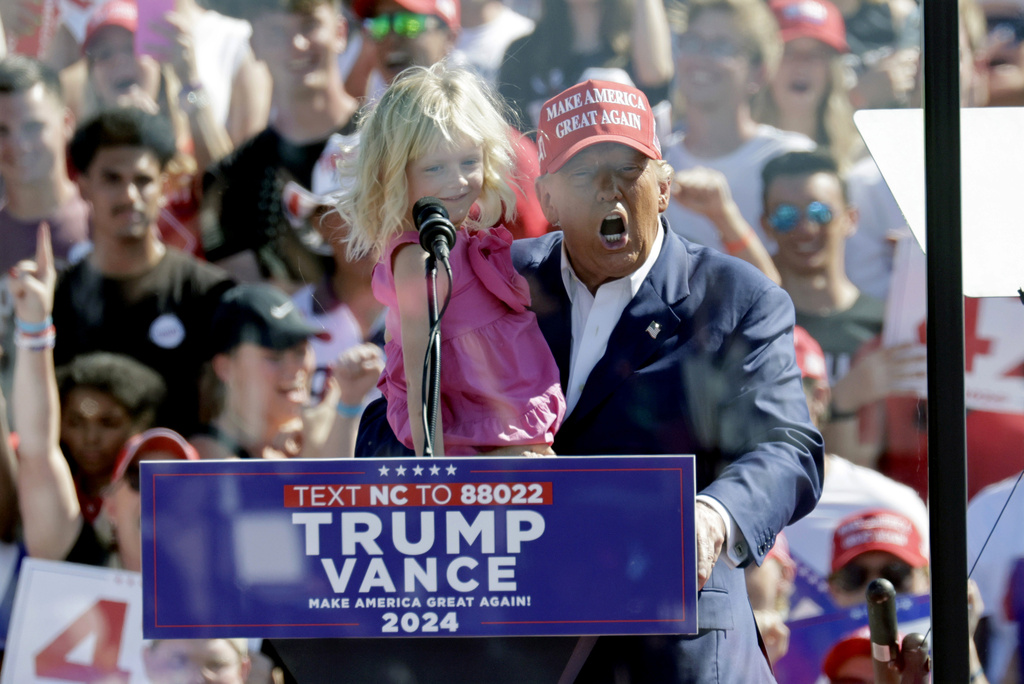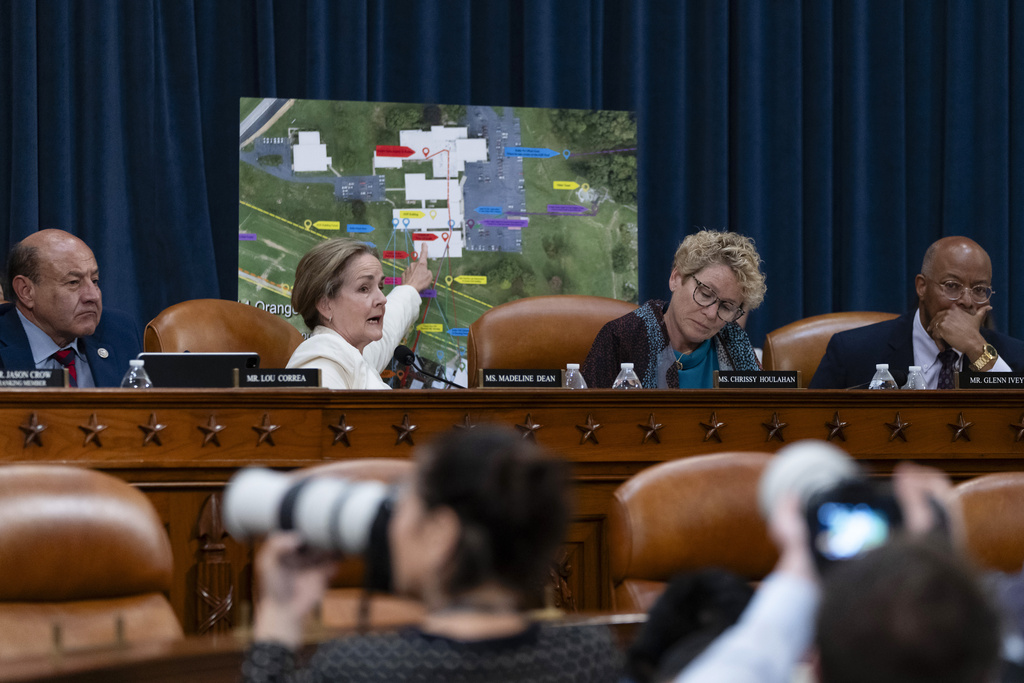Secret Service Blamed for Security Failures in Trump Attack \ Newslooks \ Washington DC \ Mary Sidiqi \ Evening Edition \ A bipartisan House task force investigating the assassination attempts on Donald Trump emphasized that Secret Service failures in communication and planning led to a gunman opening fire on the former president at a Pennsylvania rally. Lawmakers questioned why the Secret Service failed to coordinate with local authorities to secure key areas. The investigation is ongoing, with the panel expected to propose reforms by December.

Secret Service Blamed for Security Failures in Trump Assassination Attempts Quick Looks:
- A bipartisan House task force is investigating the Secret Service’s failures during two assassination attempts on former President Donald Trump, focusing on the July 13 rally shooting in Pennsylvania.
- Lawmakers criticized the agency’s lack of communication with local authorities, particularly regarding the unsecured building from which gunman Thomas Michael Crooks was able to open fire.
- Pennsylvania Republican Rep. Mike Kelly described security failures as happening “on multiple fronts,” while Democratic Rep. Jason Crow highlighted disjointed communication between the Secret Service and local law enforcement.
- The July 13 rally shooting left Trump wounded and killed an attendee, sparking investigations into the Secret Service’s response and coordination efforts.
- The hearing featured testimony from Pennsylvania police officials who stated that they were not asked to place officers or snipers on top of the building that Crooks used to shoot at Trump.
- Local police raised concerns ahead of time about the unsecured building, but they were assured by the Secret Service that it would be handled, which ultimately did not happen.
- Lawmakers raised questions about the lack of coordination between the Secret Service and local authorities, especially the absence of a unified command post and the difficulty of cross-agency communication.
- Former Secret Service Director Kimberly Cheatle resigned following intense criticism over the agency’s mishandling of security at the Pennsylvania rally.
- An interim Senate report cited failure by the Secret Service to give clear instructions to local officials and ensure real-time communication.
- The House task force is expected to propose legislative reforms to improve security protocols and ensure better communication between federal and local agencies.
Deep Look:
On Thursday, a bipartisan House task force investigating the assassination attempts on former President Donald Trump convened for its first hearing, focusing on the security failures that led to a gunman opening fire at a rally in Butler, Pennsylvania, on July 13. Lawmakers squarely placed the blame on the Secret Service, the agency tasked with protecting the nation’s top leaders, for lapses in communication and planning that allowed the attack to occur.
The July 13 incident left Trump wounded and claimed the life of an attendee, raising serious concerns about the Secret Service’s preparedness. The hearing, attended by seven Republicans and six Democrats, emphasized that the agency did not effectively coordinate with local law enforcement, particularly when it came to securing a nearby building that offered a clear line of sight to the rally stage.
Multiple Security Failures
Rep. Mike Kelly, the Republican co-chair of the committee, stressed that the failure was not the result of a single oversight but rather a series of security breakdowns. “There were security failures on multiple fronts,” Kelly stated, pointing out that Crooks, the gunman, was able to outmaneuver the Secret Service despite the agency’s reputation as one of the country’s elite security groups.
Democratic Rep. Jason Crow echoed these sentiments, praising local law enforcement while criticizing the disjointed communication between the Secret Service and local agencies. The panel spent two months reviewing more than 2,800 pages of documents and interviewing law enforcement officers as part of their investigation into the rally shooting.
One of the central questions raised during the hearing was why the AGR building, located near the rally stage, was left unguarded, allowing Crooks to climb up and fire at Trump. Lawmakers, including Rep. Pat Fallon, R-Texas, questioned how such an obvious security risk was overlooked. Fallon pointed out that “a 10-year-old looking at that satellite image” could have identified the building as a potential threat.
Lack of Coordination with Local Authorities
The investigation revealed that local law enforcement had raised concerns about the unsecured building before the rally. Edward Lenz, commander of the Butler County Emergency Services Unit, testified that his team informed the Secret Service that their shooters were inside the building, focused on monitoring the crowd. There was no “feedback or guidance” from the Secret Service to place officers or snipers on the roof to address outside threats, despite the obvious risk posed by the structure.
Drew Blasko, assistant team leader of the Butler Township sniper unit, expressed similar concerns. He said he informed the Secret Service that his team did not have the manpower to post anyone on the roof and requested additional support. According to Blasko, the Secret Service assured him they would handle it, but no personnel were deployed to the building’s roof.
Lawmakers also pointed to broader communication failures between the agencies involved. One issue raised was the existence of two separate command posts, which made it difficult for the Secret Service and local authorities to coordinate efforts in real-time. Patrick Sullivan, a retired Secret Service agent attending the hearing as an expert, remarked that this was an unusual setup. “There should be just one overall command post,” he said.
Post-Rally Fallout and Accountability
Thursday’s session was the fourth congressional hearing to focus on the July 13 assassination attempt. The high-profile nature of the attack, combined with the loss of life and Trump’s injury, has led to widespread criticism of the Secret Service’s handling of the event. Former Secret Service Director Kimberly Cheatle resigned after facing hours of questioning from lawmakers during a previous hearing, where she admitted that the agency’s failure at the Butler rally was one of the most significant operational lapses in decades.
Cheatle’s resignation did little to quell criticism, as both Democrats and Republicans have demanded more transparency and accountability from the Secret Service. An interim report released by the Senate Homeland Security and Governmental Affairs Committee on Wednesday outlined additional failures by the agency, including a lack of clear instructions to local officials and an inability to share real-time information with local partners during the rally.
Acting Secret Service Director Ronald Rowe has since acknowledged that the agency bore responsibility for the lapses, attributing them to complacency and communication issues. The Secret Service also released a five-page document summarizing key findings from an internal investigation into the Butler rally shooting. However, many lawmakers remain unconvinced that the agency has taken the necessary steps to prevent similar incidents in the future.
Next Steps and Proposed Reforms
The House task force is expected to propose a series of legislative reforms aimed at improving security protocols for protecting high-profile individuals like former presidents. These reforms will likely focus on enhancing communication and coordination between the Secret Service and local law enforcement, as well as ensuring that security risks are properly assessed and mitigated ahead of public events.
However, there is disagreement among lawmakers over whether the Secret Service needs additional funding to implement these changes. While the recently passed government funding bill includes $231 million for the agency, some Republicans argue that more money will not solve the underlying issues. They believe the agency requires an internal overhaul rather than increased funding.
The task force aims to release its final report by December 13, outlining recommendations that could reshape how the Secret Service operates and collaborates with other agencies. The outcome of the investigation may have lasting implications not only for the protection of political leaders but also for the future of the Secret Service as an institution.
Secret Service Blamed







